TOOLS OF THE TRADE
James is also well known as a vintage guitar expert and collector and is an occasional contributor to Guitar And Bass Magazine in the UK. He decided that for those interested, he'd like to share his collection.
"I have a large guitar collection. I hope it doesn't look like conspicuous consumption! My defense is I'm absolutely passionate about them. I've been hanging onto them, when I can afford it, for over 25 years! All have their own stories. The problem with having so many guitars is the space they take up (especially the cases!). I live in London, where space is a premium, so sadly I have to keep a lot of them in a lock-up in North Wales. Anyway this page is for trainspotters only - those who understand."

54 Goldtop Gibson Les Paul Standard. 4 2773 I always loved the 53-55 wrap-around Goldtops. I bought one from Tony Beastie at Antone's Guitars in Hull a few years ago but couldn't afford to keep it. I always regretted selling it, even though it had the original skinny frets, which I find hard work. About a year later, in 2004, I found another one on the internet in Vienna. I rang the shop and luckily the owner's wife, Sandra, was Scottish and could understand me. I got a flight out and bought the guitar - which had been very accurately described. Changed tuners, re-fret, non-original input surround. The 9000 Euros was a bit of a struggle at the time but boy am I glad I hung onto it when I see what they're going for now, only two years later! Nothing sounds like a 50s P90. This is the guitar I used on I Never Left on the new Alarm album Under Attack for all the picking parts. Killer! |

56 Black Beauty Gibson Les Paul Custom I got this recently. I always thought they were one of the best looking of all Les Pauls with the P90 and square poled Alnico in the neck. Many people think that any black Les Paul Custom is a Black Beauty, but the term was originally coined to describe only the non-humbucker P90/Alnico equipped guitars. This one has a refin neck and had been changed to chrome parts. I realised it was potentially a classic I wouldn't be worried about taking on the road. The P.90 has slightly less output than those on my 54 but the creamy sound, the way every string can be heard when you play a chord, prove to me, as if I need any more evidence, how right Gibson got it so early on and the Alnico in the neck position is pure tone heaven. It is one of the lightest Les Pauls I've ever encountered and has a mahogany top, rather than the usual maple, which makes it sound a bit "darker". I took the original bits off that might get damaged on the road and replaced them with reissue parts (knobs, input surround etc.). I've been using it live with The Alarm on Absolute Reality and Spirit of 76 where hearing each note in the chord, I think, is important. |

75 Gibson Les Paul Custom Ivory. 555209 I bought this Les Paul in NYC in 1980 when I went there with Mick Rossi (Slaughter And The Dogs) in July 1980 for a break after leaving Chelsea. I knew I wanted an ivory one and this was the one I liked the most on 48th Street. It's been on every record I've made since and I used it live all through the 80s with Gen X, Kim Wilde and GLJ. I kind of retired it from the road after The Cult tour of 94/5. It just has such great sentimental value to me I don't know what I'd do if something happened to it. I was kind of disappointed to discover it was a maple neck version (75 was the transition year after all) when the paint wore off the neck. But I forgave her because I love her a lot. |

74 Gibson Les Paul Custom Ivory. 416948 This is my live number two Ivory LPC. When I bought it (from Chandlers in West London) it had had all the parts changed to chrome ones. Not just the tune-a-matic and stop but also both back plates, the toggle and surround and the input jack. It even had four Tele chrome knobs and two ugly chrome covered Schecter pick-ups with no pole screws! Well it takes all sorts as they say. I had all the bits at home, so I put it back more or less to stock. Now it looks much better (in my opinion anyway). |
|
76 Gibson Les Paul Custom Ivory. 06 211721 Here is my live number one Ivory LPC. I've had it about ten years. It was my live number two until I retired my 75. In 96 when I was on tour in the US with GLJ I found a 66 Epiphone Sheraton in a pawn shop in Jackson Mississippi for 400 bucks!! (Even pre eBay that kind of thing rarely happened. I guess the pawn guy thought it was a Jap reissue). The Sheraton at the time was worth about $3500. I worked out that with the amount of time I spent looking in pawn shops it correlated to about two dollars an hour for my time! I swapped it with an LA dealer, Ricky Mahler, for two Ivory Customs - this one and a 79. I kept this one because I loved the colour it had gone, almost butterscotch. It's all stock and not too heavy for a 76. I used it for a while with the pick-up covers on. I can't tell how I prefer the look of it, with them on or off. They're off at the moment. |

72 Gibson Les Paul Custom. Black. 683465. I love the Gibson embossed pick-ups the company used on its guitars around 71/72. This guitar is like brand new and too clean to take on the road. I got it from Andy Hackett's Angel Music when he was still in Islington. I paid quite a lot for it five years ago - but it was so gorgeous I couldn't resist. |

71 Gibson Les Paul Deluxe Goldtop. 630568 I got this guitar from Rick Zsigmond (New Kings Road Vintage Guitars) around 1998. He must have been skint cos I haggled him down to 750 quid! I thought the way the gold had worn looked like a 50s one. It's a Les Paul Deluxe with 2 P90s replacing the original mini-humbuckers. I used it live with The Alarm a lot during 2000/2001/2002. |

72 brown/stripped Gibson Les Paul Deluxe In 76 I had the first Les Paul I ever owned stolen out of the back of a van in Tooting after a gig. It was a 69, non-sandwich, Les Paul Deluxe Goldtop. I still keep half an eye out for it - it had a few unique features I haven't forgotten, even after 30 years. This is the guitar I bought to replace it. I used this guitar all through my years with Chelsea and it's the guitar on the first Chelsea album. I was the person who routed it for humbuckers. I don't feel guilty because the finish was shot anyway. Roger Giffin did the job when he still lived in Raynes Park in South London before going on to greater things with Gibson etc. Later I noticed it was a ringer for Marc Bolan's Standard (before he put a Custom neck on it) so I put a Seymour Zebra in the neck to make it even more of a look-a-like (shame about the big headstock). When I was in Gen X and Billy Idol started to enjoy playing guitar live, he used this guitar a lot before he got his Gretsch Country Gent. Ricky Wilde used it on TOTP too with Kim Wilde a couple of times and Jay Aston took a shine to it in the late 80s and used it on a few GLJ US tours (See pic Sandy Garcia). The headstock has been broken at least three times (firstly by my brother Dave dropping my Fender Twin on it when we shared a flat together in the early 80s!). |

73 cherry Gibson Les Paul Custom. 180302 In the Gibson Shipping Totals book it states as many cherry Les Paul Customs were shipped in the early 70s as black ones. This has to be rubbish or a misprint, because you never see them. Maybe they got cherry and wine red confused, though I would say there are few wine examples from this period also. Anyway the cherry ones are hard to find. In the mid 90s I saw one for sale at a Bonhams guitar auction in West London. It had a very well repaired headstock break and someone had etched an SW18 London post-code on the back of the headstock too. It went for nearly a grand, which I thought was just too much at the time, in spite of the lovely colour and near mint condition apart from the break. I had a percentage in New Kings Road Guitars back then and told Rick that if he ever saw one at a show I wanted one. It was a couple of years later that he called me when I was on tour in the US and said one had come into the shop. I told him to hold it for me. When I got home I went straight in and immediately noticed the SW18 engraving on the back of the headstock. It was the same guitar! I wasn't letting it get away again. As a shareholder I haggled Rick to let me have it at the shop's cost. Being the nice guy he is, he agreed. |

74 Gibson Les Paul Deluxe. 113853 I've always had a soft spot for early 70s Deluxes. I got this one in LA in the mid 90s. I loved it because it was so flamey and the sunburst was so vibrant. It sounds absolutely killer. The mini humbuckers are slightly "sharper" sounding than a regular humbucker, with a tiny bit less output. |

73 Gibson Les Paul Deluxe. 302190 Bought this one out of Loot in London around 93. I used it with GLJ a lot around that time. I love the top on this one too. Billy Duffy borrowed it off me for his ill fated stint with Vent with Miles Hunt from The Wonderstuff in the summer of 95. If I want to use a Deluxe live this is the one I take out. I've used it sporadically in The Alarm too - when I fancy a change from a Custom. |

71 Gibson Les Paul Deluxe. 951790 I got this guitar pretty recently from the Guitar Centre in Cerritos in Orange County California. I paid quite a lot for it because I thought it was a particularly nice one. It interested me too because it doesn't have sunburst back and sides as they usually do - untypically they're cherry on this guitar. I just used it at The Alarm show at The Bowery Ballroom NYC (July 2006) and it passed with flying colours. |

80 Black Gibson Les Paul Custom. 81000502 In 1990 Gibson endorsed me and offered me two guitars for nothing. Have you got any idea how good it feels to be offered two free guitars by Gibson!! I was in Nashville in 91 on a GLJ tour and chose my black J200 (an ex-demo model that sounded incredible) and for some reason a reverse Firebird 5 reissue which I never got on with. I ended up trading it for this Les Paul with a guy in Walthamstow who wanted a Firebird and offered this LP in trade. It's an 80 Custom with an added middle pick-up. I use it live a lot; especially in Chelsea for some reason. |

81 Natural Gibson Les Paul Custom. 82891555 I bought this guitar on eBay about three years ago. It got sent to my mate Matt Bruck's house in LA, with another Les Paul I'd bought. Next time I flew out with The Alarm for a tour, I think it was summer 2004, I had a lot of luggage and decided I'd have to use one of the guitars I had there rather than take one out. They were both from the same period. I was surprised to find the Natural was really lightweight and sounded great! Bit of a Ronno vibe too. I used it for the tour and have used it often since in the studio. It's all over Under Attack by The Alarm and Faster, Cheaper And better Looking by Chelsea. |

61 Gibson SG Junior. 26555 When I saw Chris Spedding playing one of these at Knebworth in 74 with Roy Harper when I was still a kid I knew I had to have one. Motorbikin' was just a hit and Spedding was the highlight of the festival for me, the first open air one I'd been too. Pink Floyd bored me, fan though I was. I've had many SG Juniors over the years. They always just work. This one I got in Chicago (Scott Silver - Chicago Music Exchange) in 99 on the GLJ/Mission/Mike P Resurrection tour. The early ones, with the angled bridge, I always think are better than the later ones with compensated, straight across, bridges. The angled bridges lasted for about the first six months after the model's introduction. I used this guitar for a lot of the lead work on Open Mind from Glen Matlock's Open Mind album. Alain Insane borrowed it for a lot of the rhythm guitar work on IV - The Children Of The Revolutions comeback album. |

63 Gibson ES345. 100521 I bought this guitar from Norm Harris, of Norman's Rare Guitars, when I had a bit of spare cash around 2001. It's the actual guitar featured on page 170 of his collection book. It still had the original stereo lead in the case and when I plugged it in to two amps in his shop it sounded like a Hammond Organ on steroids. I knew I was having it right then. "Has it got the right patent number sticker pick-ups Norm, are there any issues, do I need to take it apart?" I asked. "It's been in my warehouse for fifteen years James, its absolutely fine." I was glad I didn't take it apart in his store, when I got it home I discovered that, unusually for a 63, it had 2 PAFs! |

68 Gibson 335 XII. 951338 I bought this guitar for 600 bucks at a guitar show in Las Vegas in 2002. It was cheap because the top had been painted white. When I got it back to the UK and plugged it in properly I discovered it was brilliant for overdriven power chords, something it was never designed for. Humbuckers are never going to be right for that jingly-jangly typical twelve string sound for sure. I decided to keep it and took it to Clive Brown to refinish the top. He rang me two months later and in his Yorkshire drawl said "James, I've got some good news for you." He'd managed to get the white paint off without damaging the original cherry that was still underneath! Sometimes there is an unexpected bonus! This is the only guitar on The Alarm hit 45 RPM apart from the power chords in the breakdown section, for which I used my 75 NYC ivory Les Paul Custom. |

51 Gibson ES350. A8086 Not something I'd probably ever play on stage but this is just a gorgeous guitar, a real work of craftsmanship. Two great sounding 50s P90s and really lovely wood, it's the sort of guitar I used to drool over in guitar books when I was a kid. It's very playable too with a great neck profile, the kind I like anyway, having quite small hands - not too big and clubby. |

66 Epiphone Casino. 821973 John Porter, producer of The Smiths and a million other bands, told me that single pick-up Gibson ES330s were his favourite guitars for recording rhythm guitar. I have a lot of respect for John, and am glad to know him personally. He was a top session guitarist in the 70s and played some of my favourite ever guitar solos, including the one on Don't Worry Baby on Bryan Ferry's first solo album These Foolish Things. I think he's right. The single P90 right in the middle has a tone all its own. The Casino, of course, was made by Gibson and is identical to the 330. This one I have is in the rarer Royal Tan finish, peculiar to Epiphones only. It's a pale sunburst Gibson never used on their Gibson branded instruments, with a literally tan coloured back and sides. Great through a Fender Super or Deluxe. |

61 Gibson J200 Acoustic. 25213 This guitar used to be Terry Britton's (Tina Turner producer etc). I saw it for sale in a shop in West London and fell in love. I couldn't afford the three grand at the time in 96 so I told my mate Simon Finch (Legendary rare book dealer) about it and he bought it (rich bastard!). I told him I wanted first refusal if he ever decided to sell it if I had some cash at the time. He did two years later and I had the money. He charged me £3500 apologising for having to make a profit. I didn't mind - I thought it was still a bargain. Gibson made 73 sunburst J200s in 61 - how many are nicer than this? Brown case an' all. |

90 Black Gibson J200 acoustic. 92700016 In my opinion a good J200 is unrivaled as an acoustic guitar. This is the guitar I got from Gibson in 91 after trying out about five in their Nashville showroom. I had an Everly reissue at home at the time and when I A B'd them it was like night and day. This has been my main studio acoustic ever since. This guitar and Mike Peter's black J200 have serial numbers about 8 apart! So they must have come from the same batch, probably all in the batch were black. I used this acoustic for all the acoustic guitar work on Heavenly Bodies, VII and The Thornfield Sessions by Gene Loves Jezebel and also The Bond Alarm sessions. |

94 Gibson J200 XII acoustic. 93553010 When Gibson brought out a 12 string J200 I knew I had to have one. I was in Vancouver rehearsing with The Cult in 94 and so I rang my mate Jimmy Archie at Gibson in NY. I told him I was going to be playing a lot of acoustic on the tour (slight exaggeration) and that I was really keen to try one of their new J200 XIIs. "OK James, as it's not a bullshit band I'll send you something over." This guitar arrived by Fedex a couple of days later. I used it on about three numbers during the set for that eight month world tour, so Gibson did get their promo monies worth. It's a blinding guitar. I've used it a lot in the studio since. All the twelve string acoustic on The Thornfield Sessions by GLJ is this guitar. |

70 Gibson Hummingbird acoustic. 963359 This guitar has the smallest volute you will ever see close to nothing and yet so far. In the studio I will almost invariably use a J200 for big strumming parts, but the Hummingbird comes out sometimes and its mahogany back and sides give it a distinctly warm sound. Much beloved by Keef of course. When they lost the double parallelogram fretboard inlay around 72 in favour of a simple block (cost cutting no doubt) I feel the look was seriously compromised. I got this guitar from a guitar shop in Romford that was closing down that I just happened to be passing. It was around 1993. 350 quid. Those were the days. |

67 Epiphone Frontier acoustic. 094903 I think these guitars, with the cactus and ropes guards, are just so cool looking. To all intents and purposes it's a Gibson Dove, of course, with the maple back and sides and spruce top. This is the acoustic on My Town on Under Attack, the new Alarm album. Here's a pic of me with it just after my carpel tunnel op. in 2004. |

Gibson Super 400 archtop. 14302 A Gibson Super 400 is like no other guitar. The design, the craftsmanship and the tone like glass. This one is a mystery. I bought it as a thirties guitar that had been re-necked in 61. The wood certainly looked thirties, but the numbers on the inside of the body, 6029 3, didn't make any sense to me. The neck had a 61 number but a 14 degree headstock pitch, which was a later feature. Could it have been a later factory ordered guitar? Gibson stopped making the acoustic, non-cutaway 400 in the mid 50s. So it's still a mystery but it's my favourite guitar to just have lying around in the front room for spontaneous playing. |
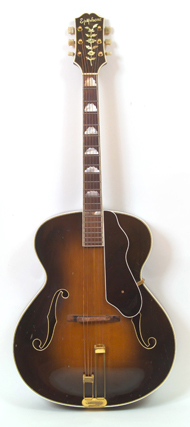
46 Epiphone Deluxe archtop. 55520 I bought this archtop in the late 90s from a pawn shop on Vine Street in LA that had a small vintage section. The back and sides had been refinished but the wood was lovely and I adored the cloud inlays. I decided I could only justify keeping it if I learned to play jazz guitar properly, something I'd always wanted to do. I bought myself a teach yourself jazz guitar book and sat down with it and the guitar. My jazz playing has improved a bit, but certainly not enough to justify owning such a lovely jazz guitar, but I do keep practicing. I often wonder what her previous owners over the past 60 years have played like and where she's been on her travels since her creation in NYC all those years ago. |

63 Epiphone Texan acoustic. 168740 Around 99 Mike Peters was telling me I should get an "Alarm" style acoustic. I wasn't gonna go for a horrible cheap thing made in China or Korea, or worse still a flat-top with a cutaway like they used to use (no offense Sharpie!). I'd seen this Texan, with an added De'armond pick-up, in a shop in Manchester and it had been bugging me for about a year. Every time I went back it was still there - until the time I decided to go and buy it! Luckily a very helpful shop assistant told me it was a consignment guitar and the owner had taken it out - he gave me the guy's number. I called him and we agreed a price over the phone and did the deal in a service station car park on the A55 that afternoon! Sounds fantastic acoustically too but the De'armond is great for a cheap, grating live acoustic sound - perfectly fitting the old Alarm classics. |

30s Carson J Robison small bodied acoustic I got this little gem off eBay in the late 90s (before the site kind of just got too big). I think I paid $250 for it! Gibson made in the 30s for the Montgomery Wards chain. Although it's a budget instrument it sounds fantastic. I love the fire-stripe guard. Basically it's a Gibson L00. It's small bodied - so it kind of sounds "small" but in a very classy way. Great for lead acoustic work. |

53 Gibson TG 50 Tenor. Y 5688 I love unusual guitar based instruments. Before this Gibson I had a Harmony tenor I bought in a pawn shop in San Bernadino for 40 bucks. Being a lazy bum I never learnt to play the tenor properly, but invented my own simple tunings to create interesting atmospheres and drones on recordings. On Dream A Big Dream from Gene Loves Jezebel's The Thornfield Sessions and VII the droning guitar is my tenor tuned in open G. |

50s Gibson EM150 electric Mandolin When I was broke I did a few tribute albums for DTK records, not under my own name of course. The mando was crucial in doing the Rod Stewart tribute as so much of the instrument is featured on his Faces recordings. I prefer using a mic to record it acoustically, rather than use the four pole P90. It was a great fun record to do and Mike Peters, Glen Matlock and Beki Bondage among others contributed vocals. Everyone who grew up in the 70s has a soft spot for the Faces somewhere. I later discovered that the first proper gig both Mickey Fitz (The Business) and I attended was the Faces gig at the Edmonton Sundown in 1973. I also discovered the best instrument to emulate Ron Wood's Zemaitis tone was an early 70s Les Paul Deluxe. |
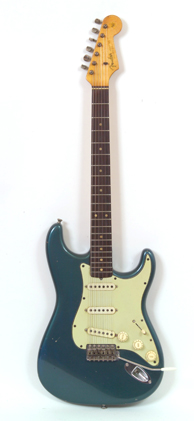
62 refinished Fender Stratocaster. 87029 This was a guitar that followed me around for about six months before I gave in and bought it. It had been for sale in Andy's in Denmark Street and I loved the colour - an old, checked, Lake Placid Blue refin. The guard was a reissue and there was a tiny rout in the control cavity where a battery had lived during its days of conversion to an active circuit. Two of the pick-ups were right but the back one was from later in the 60s. The price tag was three grand, a lot of money in the mid 90s for a refin with issues. The salesman immediately came down to £2200 which I thought was still too much. But I kept thinking about it and looked to see if it was still there every time I passed the shop. A few months later, at a guitar show in Leeds, Andy Preston himself turned up late with a few guitars for sale - one being the 62 Strat. We agreed at £1800 and he took a late 60s 335 I had in trade. Its been my main Strat ever since. This guitar, along with my blackface Fender Super, is the backbone of The Thornfield Sessions by GLJ. |
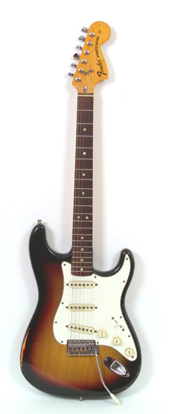
74 Fender Stratocaster. 581316 When I was in Hot Club in 1982 I owned four guitars. My Ivory Les Paul Custom, my Chelsea Les Paul Deluxe/Standard, my 70 P Bass and a Yamaha J200 acoustic copy. I really wanted a Strat. They had a sound. I knew a Strat would never be a live guitar for me, but I wanted one for that "Strat" sound. Steve Allen, the singer in Hot Club and formerly of Liverpool legends Deaf School and The Original Mirrors had one he said he'd sell me. It was Ian Broudie's old guitar. Ian had been the guitarist in The Original Mirrors of course. Great Strat. Staggered pole. Still have it. Don't underestimate a good bullet headstock Strat. |
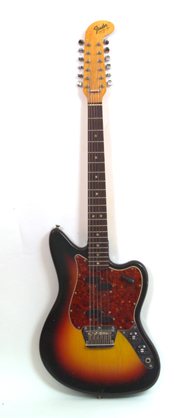
66 Fender Electric XII Sunburst. 143455 There's a story to this one. In 91 Gene Loves Jezebel had just signed to the short lived Savage Records of New York. We'd gone to LA with the producer of our choice, Kenny Jones, to record two tracks, so Savage could ascertain if we could come up with the goods with him. I'd decided I wanted a Fender Electric XII to feature largely in the recordings. We were recording at Larrabee Sound on Fairfax in West Hollywood. As soon as we arrived I hit all the vintage stores looking for one of these guitars. But of course they'd gone up since last time I was there. (Lloyd at Voltage wanted $1500 for a sunburst one, my budget was a grand). No extra money from the label, the budget was tight. Pete Rizzo (GLJ bassist) and I had got into checking out the pawn shops (pre-eBay the world was a different place!). We walked into one on Santa Monica Boulevard and I saw a Fender XII behind the counter, its original case open to display it. "What are you asking for the Fender twelve string?" I asked. "A hundred and fifty dollars" the unmistakably eastern European accent retorted. I smiled at him, assuming he was taking the piss. "That's a good price," he said sternly. He must have mistakenly thought I was smiling about his inflated price. I had no cash on me! Unprepared as usual, I raced in the rental car back to the hotel. I would get the gold medal for quick handing over of the cash while trying to look nonchalant if there was such an award. When I walked out with the guitar the feeling that I'd stolen it soon gave way to euphoria. My gut feeling that the XII was the right vibe for the album paid off. Its unique sound is all over the record, and particularly the single Break The Chain, which ended up becoming one of the biggest selling singles in Portugal of all time. Mike Peters and I used this guitar all over The Bond 5 CD set by The Alarm because I left it up in Wales for a while, but I actually prefer the sound of my blue one, which is almost identical sounding, but as with all these things, not quite. |

66 Fender Electric XII Blue Ice Metallic. 137479 This is the one guitar I bought from Fat Rick when he was at Vintage And Rare in Earls Court before he talked me into being a partner in his new venture - New Kings Road Vintage Guitar Emporium. I'd had the Sunburst about two years and Rick, being an astute dealer, knew I loved it and was up for another one. I lived in Earls Court myself at the time. "You'd better come in" he rang and suggested one afternoon, "I've had something just come in you're gonna want." The minute I saw it I knew it was coming home with me. It had faded to a colour a shade greener than the original Blue Ice due to the top coat of clear lacquer yellowing, a common trait with old Fenders. £875 was pretty reasonable too. I used it live with GLJ and The Cult (continuing as the "utility man" I used it on She Sells Sanctuary, Rain, Revolution and Nirvana). I also use it in The Alarm when we do Breathe. Mike Peters takes the piss out of me for playing that song without the aid of a capo. I just don't like the things. I know two other people who have this model in the same rare colour. Peter Svenson, the guitarist from The Cardigans and Heavenly Records boss Martin Kelly. Interestingly (well for those who may be interested) my sunburst is dot and unbound with a Feb 66 neck stamp. My Blue Ice Metallic is block and bound and has an April 66 neck stamp but an earlier serial number! I've never seen a dot and bound electric XII. |

66 Fender Electric XII Candy Apple Red. 177895 In case you hadn't guessed I really like these guitars. I got this Candy Apple one about three and a half years ago. It's brand new! It's the actual guitar pictured on page 97 of Norm's Rare Guitars book. |

66 Fender Electric XII Black. 117668 I bought this one from my friend Peter Svenson of The Cardigans fame (a man with great taste in guitars incidentally). Don't really know why he didn't keep it - I know he loves Fender XIIs. Super rare in black (in fact I've only ever seen one other, in Voltage Guitars in LA about ten years ago - but I was broke at the time). |

66 Fender Electric XII Olympic White. 133447 I saw this at a show in Manchester a few years ago and bought it - deciding I was going to start collecting this model. Next on the list is one in Lake Placid Blue and one in Firemist Gold, if I can ever afford it the way prices are going! |

66 Fender Telecaster - Candy Apple Red. 159311 I bought this guitar around 93. As I drove to Cambridge to view it I had a feeling it was an original Candy Apple Red Tele and not the "Wine Red" guitar it had been advertised as (Fender Wine Red?!). I hadn't ever owned a Tele (shameful I know), such an essential tool of the trade. When Gene Loves Jezebel were recording Heavenly Bodies in 92 I was desperate to emulate the sound George Harrison got on the solo and guitar stabs in Happiness Is A Warm Gun (where the guitar almost sounds like a baritone sax) for our song Sweet, Sweet Rain. Without a Tele I was kippered of course, but I didn't know that at the time. I struggled on with the guitars I had in my arsenal for days to no avail (surprise, surprise). The minute I plugged in this Tele I realised a simple truth - for that sound you have to have a Fender Telecaster. Nothing else sounds the same. It cannot be duplicated. No Les Paul, Strat, 335 will ever emit that sound. Then when I went on tour with The Cult in 94/95 I took this guitar on the road. Billy Duffy wanted me to be the "utility man" backing up whatever he was doing with the appropriate rhythm instrument (basically stand at the back and play A and D all night - great fun!). I used the Tele on Star and Black Sun from their new Goat album. I think that was the first time I'd ever used a Tele live, very different from having a Les Paul in your hands. Then, after a few weeks, the decal started flaking off! It had been perfect, but now some of the gold within the black outline of the logo was flaking off! I found myself distraught and panicking! It had survived intact for thirty years and now I, having selfishly decided to take it on the road, into all those humid venues, was solely responsible for destroying its enjoyment for posterity. In Australia I rang every vintage guitar shop I could find in Yellow Pages to find an early seventies model with the more hardy black CBS logo in vain. As soon as we got back to the UK I retired it from the road. |

66 Fender Telecaster - Blonde. 185663 I got this Tele from a guy called Sven around 96. He worked in a shop called Blue Audio in Islington. I bought a copper panel Vox AC10 from him at the same time too. I couldn't afford to keep them both so Rick at New Kings Road Guitars sold the AC10 to Vox fanatic, big wadd geyser and man about town Noel Gallager. But I still couldn't afford to keep the Tele. At the time I had a Lake Placid Blue 66 Jag I'd picked up cheap. But I couldn't get a sound I liked out of it. A mate of mine - Elliot Hough - said sell the Jag, the Tele's a man's guitar. I had to agree with him there! Great advice. At the time they were worth about the same. This is the guitar I used for all the lead work on Ambition on Glen Matlock's Open Mind album. It's my "studio" Tele. |
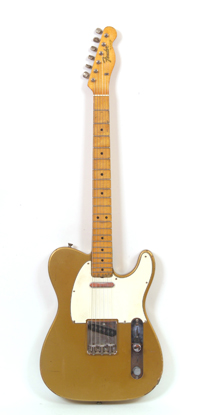
62/7 ish Fender Telecaster Clive Brown Firemist Gold refin. This guitar is a Frankenstein which I created myself about 5 years ago. I got a 62 body in a trade I did that had been Duluxed red! You could see the brush strokes! I already had both the right pick-ups and a mid 60s guard in my parts drawer. I got all the other bits off eBay over the next year or so including the neck. There was only one man to do the refin - Clive Brown - in my opinion the best aged refinisher in the world. It's been the Tele I use live ever since I got it back from him. |

70 Fender Precision Bass. 303876 I bought this bass off a German guy in London in 73 when I was still at school. I'm the twat that sanded the sunburst finish off it! I played bass in bands at school before switching to guitar around 75 and still love to play bass when I can. I played a lot of the bass on "The Bond" 5 CD Alarm set and I used this bass. I think I played all the bass on the first 2 Cds including Trafficking etc. Craig Adams was going to replace it but said he couldn't improve on what I did! I don't believe him, but what a nice guy. This bass has been more borrowed than any other instrument I own and is on so many records I just can't remember them all. I even lent it to Chris Bashford, Chelsea drummer, when he played bass for The Boys on their 81 European tour. You can even see Henry "Daze" Badowski playing it on the back sleeve of Right To Work, Chelsea's first single. |
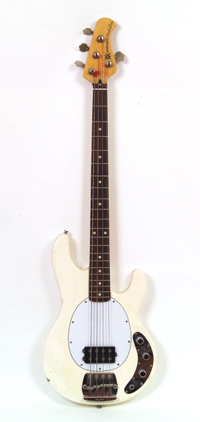
80 Musicman Stingray bass. B022900 Although these basses have become very associated with the 80s they are still one of the best sounding bass guitars ever made. This example, before the company was acquired by Ernie Ball, is unusual not only for its factory white finish, but also its rosewood fingerboard. I bought it in London about ten years ago. The gentleman I got it from told me the truss rod was adjusted as far as it would go but the neck was still slightly bent and gave me an extra discount. Philippe Dubreuille managed to sort it out no problem. |

70 Rickenbacker 4001 Bass I've never owned a Rickenbacker guitar, just one of those things, though I can see the appeal of some models. But I always loved 4001's. I love playing bass and this one comes out fairly often. I got it about 8 years ago from the bass player from Dr And The Medics. He was sad to see it go and I kind of felt guilty but I reassured him it was going to a good home and it has done. |

59 Gtretsch 6119. 33139 I'm not a Gretsch guy, but I did a session many years ago when I suddenly realized the tone I needed was a Gretsch. I didn't go out and buy the first one I saw, instead I hung on. When I was in Munich with Pete Walsh playing guitar on the German band The Seer he was producing I stumbled across this guitar in the same shop I bought the Orange Matamp mentioned elsewhere. One single PAF Filtertron. All the Gretsch tone you'll ever need. |

77 Martin D35. 390137 I've always been, and still am, a Gibson man by heart when it comes to acoustic guitars, but recently I needed an acoustic with a proper internal pick-up system for some Alarm radio promotion for Under Attack. We were promoting the album at various radio stations in New York and part of the interviews consisted of us performing acoustic versions of a few of the songs live. The Martin was the first decent acoustic I could find with a pick-up system and it just sang. I always preferred D35s to D28s because I like a bound neck. I didn't have a rosewood bodied acoustic either so now this is probably a keeper. |
Amps

66 Marshall plexi Super Tremolo 100 I've had this amp since 1977. I bought it out of Melody Maker from a guy in Wandsworth. I was the idiot who installed master volume (though it has come in handy many times). I remember the guy that did the job asking "are you sure you want it on the front? This is a plexi fronted one." That was extreme knowledge in 77. I had it nicked (well, taken anyway) from outside Shepherd's Bush Empire after a Mike Peters gig in 98. The idiot of a man from Peter Webber Hire left it and my basketweave 4x12 on the pavement instead of loading it into his van! I didn't realise until the next day when it wasn't delivered with the rest of our gear to MTVs Camden Studios where we were playing two tracks from Mike's new solo album, Rise, live. I thought my half stack must have been left at the Empire, which in itself was bad enough, and popped by on my way home from Camden. There was my basketweave 4x12 on the pavement! The most amazing thing was that it was still there nearly 24 hours later! But my amp wasn't. I was devastated. That amp had been on almost every record I'd ever made. I decided to put two days of my life into getting it back. I rang every dealer I knew asking them to be on the lookout. Phil Harris of Harris Hire told me to forget the police - advertise locally offering a reward and no questions asked. The local paper ran an article and, taking Phil's advice, put ads with a reward offered in every local newsagent. All to no avail at first. About three months later I was interrupted on the phone by my call waiting. A meek voice said "I don't know how to say this "I've got you amp." I got rid of my other call bubbling with excitement. I wanted to meet him now! We arranged to meet in a pub on Goldhawk Road in Shepherd's Bush The Orange Kipper. As I raced north down the Earls Court one way system I started to have doubts. Orange Kipper red herring - It's a wind up! I'd never heard of the pub either - and I'm a West London boy. The guy had told me he'd bought it in good faith for £150 and just wanted his money back. I'd been offering a £200 reward! I went into the pub which reassuringly did exist. Nothing. Then I looked down the street. Approaching in the evening half light of a summer sunset was a tall man about my age. He wore the clothes of the homeless. My amp was wrapped in a tartan blanket and he was wheeling it towards me in a Sainsbury's Supermarket trolley. I was over the moon. I gave him the cash and put the amp in my boot. Then I thought I'd thank him again, but when I turned round he was gone. There was no sign of him anywhere. I looked in the pub and down both sides of Goldhawk Road. As I drove home elated I felt a certain other worldliness to the whole episode. Had I met my guardian angel? This is still my favourite amp. I don't take my eyes off it now. Ever. |
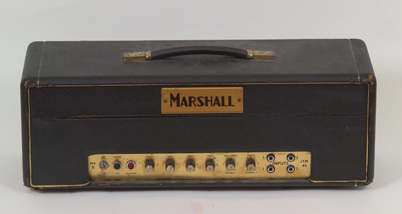
65 Marshall JTM45 In 96 I bought a mint script logo JTM 45 from a shop in South London for 550 quid! (yeah, yeah, yeah, those were the days). It was in Ricks for a service when he rang me to say he'd been offered silly money for it by an Italian guy (a grand). I stupidly took the money - thinking I'd find a replacement cheaper. I couldn't find one! I guess they're mostly in California and Tokyo now. About a year later I got offered this scruffy late block logo version (probably a 65) for £650. It sounds incredible, especially with a Tele for some reason, and it will not be for sale in my lifetime. |

65 Marshall JTM45 2x12 "Bluesbreaker" combo. This is a first series "pinstripe" grilled Bluesbreaker, the model before the Clapton series two. Sounds just as good though! You never see these things for sale right? When I got a call from someone I knew at 8am on a Sunday morning saying they had one for sale, albeit recovered, I went straight over to see it. We agreed a price and I bought it on the spot. Can you imagine how I felt when I got it home and after a little tug on the recovered vinyl it peeled off like wallpaper to reveal all the original covering underneath! Well if you can't let me tell you, it felt pretty damn good! |

65/6 Marshall 18w combo I wont say too much about acquiring this amp except I bought it in a shop in London for much less than its worth because they made a mistake about what it was. This one used to belong to Mick Green of The Pirates apparently. They're a Marshall holy grail of course. Paul Goodhand-Tait of Ampaholics told me he's had four in thirty years of dealing vintage amps - so hardly on the common side. This is an early one with the two, small, Vox style vents. Probably from 65. I get offered silly money to sell it sometimes. But when I plug it in I know it aint goin' anywhere. Scruffy as hell - it just rock and rolls! |

66/67 Marshall JTM 100 This is one of the rarest of all Marshall heads. In fact this one I own is the only one I've ever seen in the flesh. The first 4 input 100 watt Marshalls were nicknamed the JTM 45/100 because Marshall didn't have any 100 watt panels so they used the JTM 45 panels from their successful 50 watt range while waiting for 100 watt panels. I've seen quite a few of those. The inverted JTM panels are quite often seen on the 50 watt heads that were made immediately after the original JTM 45s were retired around 67, but a 100 watt four input Marshall with an inverted JTM logo is something I'd never seen until I bought this amp from my friend Chris Moores, although there is a photo of one in the colour section of Mike Doyle's Marshall book. This amp shares the huge lay down mains transformer it's predecessor the JTM 45/100 utilized, but the JMP 100 that followed later in 67 doesn't. Sonically it's all Marshall. Loads of headroom and dark overdrive. The "Brown Sound" on quaaludes. |

67 JTM 50 These are the first 50 watt amps made by Marshall. The JTM 45 was always rated at 45 watts. More common than the 100 watt version but still on the "hard to find" list. I got this one from my friend Mark Bigwood - the rock and roll doctor. |

69 Marshall JMP 50 One of my favourite sounding Marshalls ever is the "smallbox" 50 from 69 - 71. These first metal panel Marshalls have loads of overdrive and can sound quite harsh in some ways sonically. But when you get the settings right they ooze just the right distortion - loads of highs with a gorgeous rounded bottom (no pun intended). I've had loads of these over the years. It may be my imagination but the ones from 69 always seem to sound the best. |

Purple Marshall 100 watt half stack I've had the amp about 15 years. The head is an A serial number from 69/70. I bought it from Chandler guitars in West London who said it used to belong to Len Tuckey, guitarist from Suzi Quattro's band. About six months later I stumbled across the 4x12! The 4x12 is unusual in being a basketweave cab in a custom colour but still with the leather handles on top! Maybe it's a pinstripe that was re-grilled and recovered in the factory back in the 60s. Otherwise it's probably the earliest purple Marshall cab in the world. I used this half stack when I did the world tour with The Cult in 94/5. The amp didn't seem to overdrive as much as I wanted so it was the one time I linked the channels together for extra gain. Four 25 watt Greenbacks of course. |

67 Marshall 20 watt head and 4x10 cab. Here is another rarity I got in the past couple of years. The twenty watt heads do crop up - they're uncommon rather than rare. But this first version with the mains input on the front plexi panel is very rare. This one I own is the only one I've seen outside pictures. Sounds absolutely brilliant through the matching basketweave 4x10 cabinet loaded with Celestions. Like a condensed full plexi stack. |

67ish Marshall Basketweave 4x12 I guess you just have to have one of these. The classic Marshall 4x12 cabinet. I've been on the road with this one (no longer) and it was the cabinet I found in the alley at the side of the Shepherd's Bush Empire when Peter Webber Hire left my gear on the street after a gig there with The Alarm in 98. Unbelievably the cab was still there 24 hours later! |

Early 70s Marshall Checker 2x12 Great sounding, portable and good looking early 70s 2x12. I use this at home all the time as my "home recording" cabinet. |

80s 100w Marshall JCM800 model 2210 I have two of these. One of them is the only amp I've ever bought brand new, in 86 when Gene Loves Jezebel were recording The House Of Dolls (when everyone was still speaking!). I used it a lot on that album. They're great amps. Roadworthy, reliable. In GLJ I need a clean sound for some sections, which is why I use these channel switching amps with the band. I keep one in the US. When space in the bus is tight I use it with a matching JCM800 2x12. They have my favourite post greenback Celestions - the 65 watters. |
 
78 Marshall JMP 100 and 50s I have two of the 100 watt versions and one fifty. They're my Alarm amps. I use them with JCM 800 4x12s (although I just started using a checker 4x12 I've just got with 30 watt Celestion G12Hs, my favourite speakers). I think the 65watt Celestions are much better sounding than the 75s. Mike Peters has a great sounding 50w version too. In my opinion these are the best value amps on the second hand/vintage market. Classic Marshall overdrive and tone (in spite of the pcb) and roadworthy to a T. Get one while they're still cheap! |
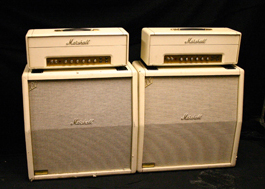
90s White Marshall reissues Over a period of a couple of weeks a few years ago, all in different places, I stumbled across these quite rare limited edition white Marshall reissues from the 90s. Two white JMP 50 watt half-stacks and a white reissue Bluesbreaker. Mike Peters and I bought them and we use them on and off as The Alarm back-line. You have to admit they do look great under the lights! |
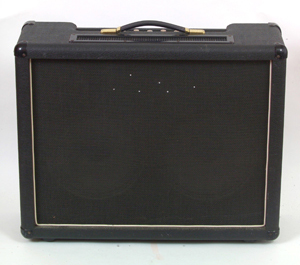
1978 Marshall JMP 50w 2x12 Combo Cheap workhorse that every guitar player should own. When you get a good one they rock! Handy if you're driving yourself to a small gig and the master volume is so useful. I've found the 50 watt versions often sound better than the 100s. This is my favourite "chug 8" amp. Its what I used for nearly all the guitars on Ritalin Kid from the new Chelsea album Faster, Cheaper And Better Looking. |

69 Park 45 I got this amp from Charlie Chandler's Guitar Experience in Hampton, West London, around 2001. I love Parks. There's something so cool about them. Probably the fact that they're Marshalls in disguise but not many people realise it yet! (Just in case you don't know and you're interested, when Jim Marshall signed a new, exclusive distribution deal with Rose Morris in the late 60s he left his previous distributor, a mate in Birmingham, in the lurch, so he agreed to carry on supplying his friend with amps but he had to rebrand them so as not to annoy Rose-Morris. Parks are Marshalls under a different brand. Just like Epiphones made in Kalamazoo in the sixties are Gibsons in reality). This small-box Park from 69 is a small-box metal panel JMP 50 in different clothing. The chassis' are identical, right down to the "lay down" mains transformer. It has all the harsh attack of the Marshall along with that killer overdrive and smooth distortion. I thought this amp sounded so great I hardly used anything else on In The Poppyfields, the first album I made with Alarm. 45RPM, the hit off the record, is this amp only. |
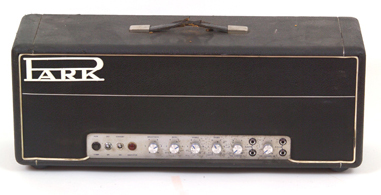
1970 Park 75 I love Parks as I said - although they're Marshalls in disguise they never quite sound the same. Vive le difference! This one from 1970 has KT88s. They seem to just growl more than EL34s. I used it a lot on Under Attack for rhythm stuff. |

69 Pete Townshend spec. Hiwatt 100 SAP103 Don't know if this amp ever belonged to Pete but I got it in West London and the Hiwatts with this spec - a volume control for each input and an extra pre-amp valve - were made specially for Pete by Dave Reeves himself. Super rare thing and sounds killer. Serial number 715 dates it to 69. There is a picture of it on Pete Townshend's gear site http://www.thewho.net. |

Fender Deluxe amp. 1949. This is only the second tweed Fender amp I've ever owned. The first was a 58 Vibrolux and boy do I regret selling it. I used it all over the Gene Loves Jezebel album VII but afterwards decided I had enough amps and couldn't justify keeping it. Silly boy. Anyway I love this Deluxe, though I've yet to record with it. |

66 Fender Super Reverb amp Aspen Pittman has described these as The King Of Clean - and he's not wrong! For almost all the guitar stuff on The Thornfield Sessions by GLJ I used my 66 Super and refin 62 Strat. Straight in - instant tone. I got this amp out of Loot in 1993 from an American girl who was going back to the US and decided to sell her amp rather than take it home with her - good girl! £375 very well spent. |

Mid 70s Fender silverface Twin I bought this amp in 82 out of the old Exchange And Mart. Cost £220 then (there have been better investments in the vintage guitar/amp world). Fitted with ATC speakers this amp is a roadies nightmare - the heaviest Twin of all time. I bought it for a John Watts tour of Europe after I went off my Musicman 4x10 combo, which, when I listen to old recordings of it now, sounded great! John, formerly of Fischer Z and a big star in Europe, had approached me in the old Marquee in Wardour Street (where I lived for a number of years) about playing in his touring band. I'd met him when I'd been doing TV shows in Europe with Kim Wilde and we'd got on immediately. Later on I found this amp worked great with my 74 Strat for clean stuff and used them together a lot in GLJ recordings including all the rhythm guitars on Beyond Doubt on Discover, our only top 30 UK album. I also used it with a Les Paul for the main riff in Heartache. Great with a Fender Electric XII too. Before I had my Blackface Super this was the amp I used for recording XIIs. All the electric XII string parts on Break The Chain and a lot of other stuff on GLJs Heavenly Bodies is through this amp. |

64 blackface Fender Deluxe amp When The Alarm was on tour in the US in the spring of 2004 we had to buy a backline (at the end of the tour we sold the whole lot to my mate and California dealer David Swartz. He gave us more or less what we paid for the whole lot). We flew in and hit a Guitar Centre in New Jersey before the first gig, knowing we had to buy the lot then and there. I got a plexi 100 reissue (incidentally probably the loudest Marshall I've ever come across) and Mike opted for a modern Tweed Fender over this Deluxe. He thought it was too quiet for live - maybe. But it sounded awesome! And it was mint! And Guitar Centre were selling it too cheap, $650! I couldn't resist. I put it on a card and they shipped it back to England for me. I use it all the time. It has a real classic tone. Great for rhythm picking and chords that don't want to be too "Marshally." Works great with a Tele, Strat or Les Paul. All the picking parts in the bridge of "Living In The Urban UK" from the new Chelsea album are a Les Paul through this amp. |

65 blackface Fender Vibrolux Reverb I traded this amp with my friend Scott Smith at Pro Analog (check out his great hand made pedals if you get a chance). He said it was a great sounding one and he wasn't wrong. Mikey P used it a fair bit on Under Attack. When the song Without A Fight breaks down and there's just one guitar playing the chords that's Mike, his 70 black Tele and this amp. |

Late 60s Orange Matamp half stack I bought the amp in a shop in Munich in 96 when I was out there doing a session for my mate Pete Walsh. Serial number 32! It's a 50 watt version. It sounds very different from your typical OR Orange. Much more overdrive. Matching Cab came a couple of years later. Greenback 20 watters. Because of the heavy construction Orange cabinets sound unique. I guess weighty is the word! |
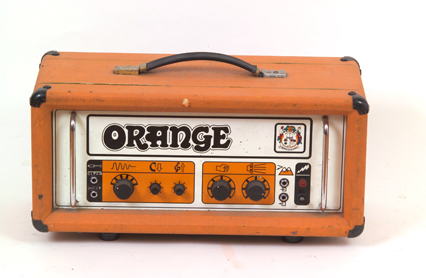
Mid 70s Orange OR120 amp This is a really good sounding OR120 that used to belong to Wayne Currillo from Missing Persons and Duran Duran. In my opinion Orange heads work best with a Strat. Loads of headroom. Tone to the bone I believe is the expression. |
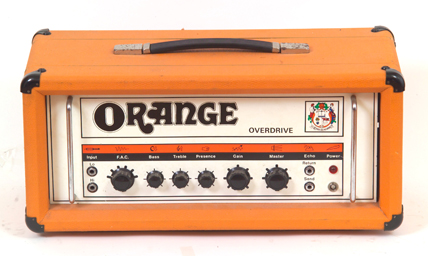
Mid 70s Orange Overdrive 120 amp. I love Original Orange amps. I think they're very under-estimated in the vintage market, although this is starting to change. The Overdrive heads were made in the mid 70s and are uncommon. I don't know how they altered the circuit compared to the regular OR120s but they tend to overdrive more of course, in fact they sound more like Marshalls. |

Gibson Atlas amp. 1964 I took this to a guitar show on my way to Wales a few years ago. I was going to sell it but nobody offered me the 250 quid I was after so I took it with me. When I got to North Wales to work on the 5cd Bond by The Alarm I plugged it in and discovered I loved it, although it only sounded good with everything turned up full. It gave loads of natural compression. I used it for the main guitars on Federal Motor Voter, both The Bond and the In The Poppyfields album version. |

60s Scala Sometimes you need a bit of "doody" on a record. When you want something that's not too big sounding but still has a tone these amps can work a treat. The first guitar on Under Attack - the intro to Superchannel - is this amp. They were made by John Dallas Industries in the 60s before he teamed up with Ivor Arbiter to form Dallas Arbiter. They were made under a few different brand names. The black one I have is badged "Shaftesbury 66". Love it. |

Dick Denny's 64 Vox AC10 I bought this from a lifelong friend who said he got it from Dick Denny's son in law after the Vox co-founder died. He hammered me on the price - but it was the best sounding AC10 I'd ever heard. Denny must have done some special tweaking. |
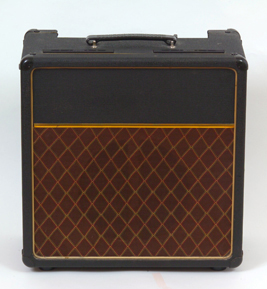
Vox AC10 single. 1965. This is a transition amp I bought off my mate Henry Badowski. It has brown grill but the grey JMI panel. Mike Peters used it a lot for his rhythm parts on Under Attack. It sounded great with his black 1970 Tele. |

Selmer Little Giant. I think there are four versions of this cute little amp and I have them all. Again, a great "doody" amp. They sound small without sounding thin. On "Trafficking" from The Alarm's Poppyfield Bond Collection and the In The Poppyfields album I used the croc-skin version for the intro guitar before the band comes in and the Marshalls take over. |
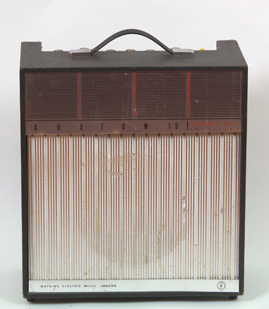
Watkins Custom 15. While we're on the subject of "doody" here's my last one, although they sound almost too good for that classification . Really great sounding little amps these, made in the 60s. I believe it's the only amp that ever used ECL82 output valves. I've got a lot of respect for old Charlie Watkins. He still answers personal emails (even though he's in his 80s) and made lots of cheaper amps that sound great. |

68 Leslie guitar rotary cabinet (made by Fender) Here's a story. I was in Phoenix in the late 90s with GLJ and saw this in a pawn shop. I wanted to buy it but it wouldn't fit in the mini-bus. It intrigued me - I'd never heard one before. A Leslie cab you could put a guitar head through. I soon found out it's the same thing as a Fender Vibratone. Fender had bought Leslie in the late 60s. This is a 68 and has that chrome trim round the grill you get on only 68 Fender amps. When I got back to LA a friend said those things are amazing! 90 bucks! Are you crazy! The girl that ran the Gene loves Jezebel website lived in Phoenix and when I got back to London I asked her if I bought it over the phone would she collect it? She would and did. Thanks Dena if you're out there! A few months later I was at a guitar show in Dallas. My mate Rick Zsigmond had bought a load of stuff for his shop and said if I got the Leslie to his shipper I could put it in with the shipment. It all went according to plan. A month later I was in Ricks shop anticipating the imminent arrival of the shipment. When I unpacked it and plugged it in & nothing. I took the back off and everyone fell about laughing no speaker! Anyway I got the right Jensen in the end and can say it was all worth the trouble. You need to mic them with three mics in stereo but what you get cannot be duplicated by any pedal - not even my Shinei Psychedelic Machine! I always take it to album recording sessions. Its all over Kaleidescope and Festival of Light on The Alarm "The Bond" collection as well as the title track from In The Poppyfields. Pete Walsh also recorded it with devastating effect on Dream A Big Dream on the GLJ album VII. |
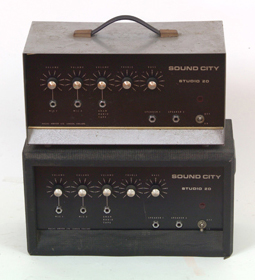
60s Sound City Studio 20 My friend Matt Bruck, man Friday to EVH and general tome of knowledge and writer for Guitar World, turned me onto these killer yet underrated amps about five years ago. I reckon with the "gram" input etc these amp must be 60s. They do have a PCB, but I guess PCBs were around in the 60s. They sound great. They'll give a Marshall 20 a serious run for its money (in fact I often use the Sound City in preference to my Marshall 20 watter) and they use the same valves - EL84s. I used this amp a lot on the new Chelsea album, Faster, Cheaper And Better Looking especially for lead stuff - Living In The Urban UK - etc. I used it with the early 70s checker Marshall 2x12 with greenback 30Hs. If you play guitar and see one on eBay , buy it. |

